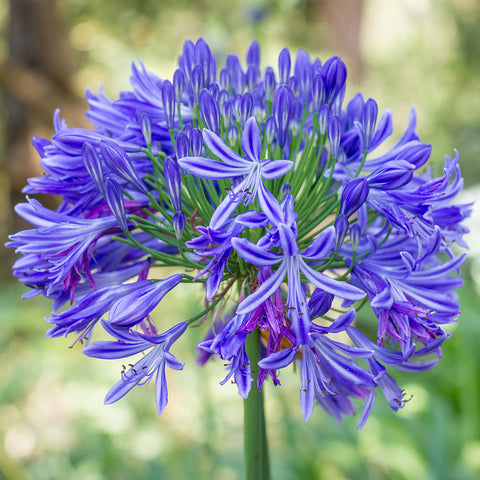Typical Agapanthus Issues and How to Resolve Them
Typical Agapanthus Issues and How to Resolve Them
Blog Article
Mastering the Art of Agapanthus Treatment: Vital Actions for Healthy And Balanced Growth and Vibrant Blossoms
In the realm of gardening, the farming of agapanthus stands as a fulfilling endeavor for those who look for to nurture these classy flowering plants. With their striking flowers and graceful foliage, agapanthus has actually captured the attention of garden enthusiasts worldwide. Nonetheless, achieving optimum growth and dynamic blooms calls for a nuanced method that encompasses numerous essential steps. From selecting the ideal selection to understanding pruning methods, the trip towards cultivating prospering agapanthus plants is diverse and holds the key to opening the full potential of these botanical gems.

Choosing the Right Agapanthus Variety

When selecting the best Agapanthus range for your yard, take into consideration factors such as environment viability, bloom color, and growth routine. In addition, take into consideration the environment in your region to make sure the Agapanthus range you select can thrive in your details problems. Understanding the growth behavior of different Agapanthus selections is essential for correct positioning within your yard.
Perfect Growing Problems
Taking into consideration the ideal ecological needs is vital for effective Agapanthus cultivation. Agapanthus plants are sensitive to cold temperatures and must be shielded from frost during wintertime months.
To make certain healthy and balanced development and dynamic blooms, plant Agapanthus bulbs at a depth of concerning 2-4 inches and room them 8-12 inches apart. Mulching around the base of the plants helps maintain moisture and reduces weed growth.
Watering and Feeding Tips
Keeping proper moisture levels and giving necessary nutrients are crucial elements in the treatment routine for Agapanthus plants. When it concerns sprinkling Agapanthus, it is critical to strike a balance. These plants prefer continually damp dirt however are vulnerable to root rot if overwatered. Throughout the expanding period, water deeply when a week, guaranteeing the soil is well-draining to avoid waterlogging. In hotter environments or during periods of drought, more constant watering might be necessary to keep the soil equally damp. Nevertheless, reduce watering in the winter months to protect against water logged conditions.
Fertilizing Agapanthus is essential for advertising healthy and balanced growth and respected flowers. Use a balanced fertilizer, such as a 10-10-10 formula, in the very early spring as brand-new growth arises. Repeat this application every 6-8 weeks throughout the expanding see post period. Avoid too much fertilization, as it can cause rich foliage at the cost of flowers. Constantly adhere to the maker's instructions for correct dilution and application methods. By following these watering and fertilizing tips, you can guarantee your Agapanthus plants prosper and generate dynamic, lasting flowers.
Trimming Techniques for Agapanthus
Trimming Agapanthus plants at the ideal times and with correct strategies is crucial for maintaining their health and wellness and advertising ideal growth and flowering. The excellent time to trim Agapanthus is in late wintertime or very early spring before new growth emerges. Begin by removing any type of dead or yellowing fallen leaves near the base of the plant. Cut them as close to the ground as possible without harming the arising shoots.
Deadheading invested flowers can likewise redirect the plant's energy into generating even more blooms rather than establishing seeds. If you want to collect seeds for propagation, leave some blossoms to mature and dry on the plant.
Remember to make use of tidy, sharp tools to make specific cuts and lower the risk of introducing conditions. Agapanthus. Routine pruning will help keep your Agapanthus looking cool and healthy while ensuring an abundant screen of gorgeous blooms
Dealing With Usual Insects and Illness
After making certain proper pruning methods for Agapanthus, it is vital to deal with typical parasites and conditions that can influence the health and wellness and vigor of these plants. Agapanthus plants are typically sturdy yet can still succumb to particular problems. One usual bug that affects Agapanthus is the Agapanthus gall midget. This tiny, orange fly lays its eggs in the vegetation, bring about distorted development and flower buds that stop working to open. To fight this parasite, prune and damage any kind of damaged plant parts and think about utilizing insecticidal soap.
Furthermore, Agapanthus plants can experience from root rot if they are planted in badly draining pipes soil. By being alert and taking punctual activity against diseases and insects, you can assist your Agapanthus plants grow and create lively blooms. Agapanthus.

Verdict
Finally, mastering the art of agapanthus care includes selecting the right selection, offering excellent planting conditions, appropriate watering and fertilizing, proper pruning strategies, and resolving common insects and conditions. By complying with these crucial steps, you can make certain healthy and balanced development and lively blossoms for your check agapanthus plants. Remember to consistently monitor and keep your plants to promote their overall well-being and long life.
To make sure healthy and balanced growth and vivid flowers, plant Agapanthus light bulbs at a deepness of about 2-4 inches and space them 8-12 inches apart. By following these watering and feeding pointers, you can guarantee your Agapanthus plants prosper and create dynamic, long-lasting flowers.
One common insect that impacts Agapanthus is the Agapanthus gall midge. Furthermore, Agapanthus plants this contact form can endure from origin rot if they are grown in inadequately draining pipes soil. By following these vital steps, you can make sure healthy development and lively flowers for your agapanthus plants.
Report this page